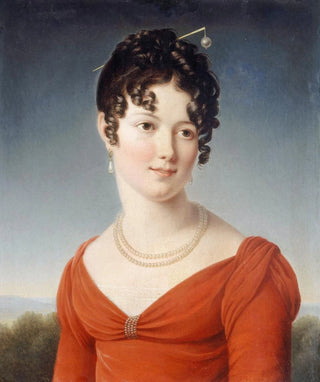Painting Bust Portrait Of Alexandrine-Anne De La Pallu Marquise De Flers 1786-1832 - François Gérard | Art print


View from behind

Frame (optional)
The bust portrait of Alexandrine-Anne de la Pallu, Marquise de Flers, created by François Gérard between 1786 and 1832, is a work that embodies the elegance and refinement of the Neoclassical period. This painting, which captures not only the physical beauty of its subject but also her spiritual essence, is a true testament to 18th-century French art. Gérard, with his unparalleled talent, manages to immortalize the grace and dignity of the marquise, offering viewers a window into an aristocratic world imbued with sophistication. The finesse of the details and the depth of emotion conveyed in this portrait make it a must-have for art and history enthusiasts.
Style and uniqueness of the work
The style of this piece stands out for its striking realism and psychological approach. Gérard, a master of portraiture, employs chiaroscuro techniques to highlight the delicate features of the marquise and to create an intimate atmosphere. The composition is carefully thought out, where each element, from the draping of the gown to the shimmering jewelry, contributes to the overall harmony of the work. The color palette, both soft and luminous, enhances the impression of nobility and serenity emanating from the portrait. The marquise, with her penetrating gaze and enigmatic smile, appears almost alive, inviting viewers to ponder her thoughts and emotions. This ability to transcend mere physical representation and touch the soul of the subject is what makes this work so singular and memorable.
The artist and his influence
François Gérard, born in 1770, is one of the most renowned portraitists of his time. Trained under Jacques-Louis David, he established himself in the Parisian artistic scene thanks to his technical skill and artistic vision. Gérard captured the spirit of his era, blending classicism and romanticism in his works. His influence on French portraiture is undeniable, and he inspired many artists who followed in his footsteps. By creating portraits of notable figures, he left a lasting legacy in the world of art.

Matte finish

View from behind

Frame (optional)
The bust portrait of Alexandrine-Anne de la Pallu, Marquise de Flers, created by François Gérard between 1786 and 1832, is a work that embodies the elegance and refinement of the Neoclassical period. This painting, which captures not only the physical beauty of its subject but also her spiritual essence, is a true testament to 18th-century French art. Gérard, with his unparalleled talent, manages to immortalize the grace and dignity of the marquise, offering viewers a window into an aristocratic world imbued with sophistication. The finesse of the details and the depth of emotion conveyed in this portrait make it a must-have for art and history enthusiasts.
Style and uniqueness of the work
The style of this piece stands out for its striking realism and psychological approach. Gérard, a master of portraiture, employs chiaroscuro techniques to highlight the delicate features of the marquise and to create an intimate atmosphere. The composition is carefully thought out, where each element, from the draping of the gown to the shimmering jewelry, contributes to the overall harmony of the work. The color palette, both soft and luminous, enhances the impression of nobility and serenity emanating from the portrait. The marquise, with her penetrating gaze and enigmatic smile, appears almost alive, inviting viewers to ponder her thoughts and emotions. This ability to transcend mere physical representation and touch the soul of the subject is what makes this work so singular and memorable.
The artist and his influence
François Gérard, born in 1770, is one of the most renowned portraitists of his time. Trained under Jacques-Louis David, he established himself in the Parisian artistic scene thanks to his technical skill and artistic vision. Gérard captured the spirit of his era, blending classicism and romanticism in his works. His influence on French portraiture is undeniable, and he inspired many artists who followed in his footsteps. By creating portraits of notable figures, he left a lasting legacy in the world of art.
12,34 €






